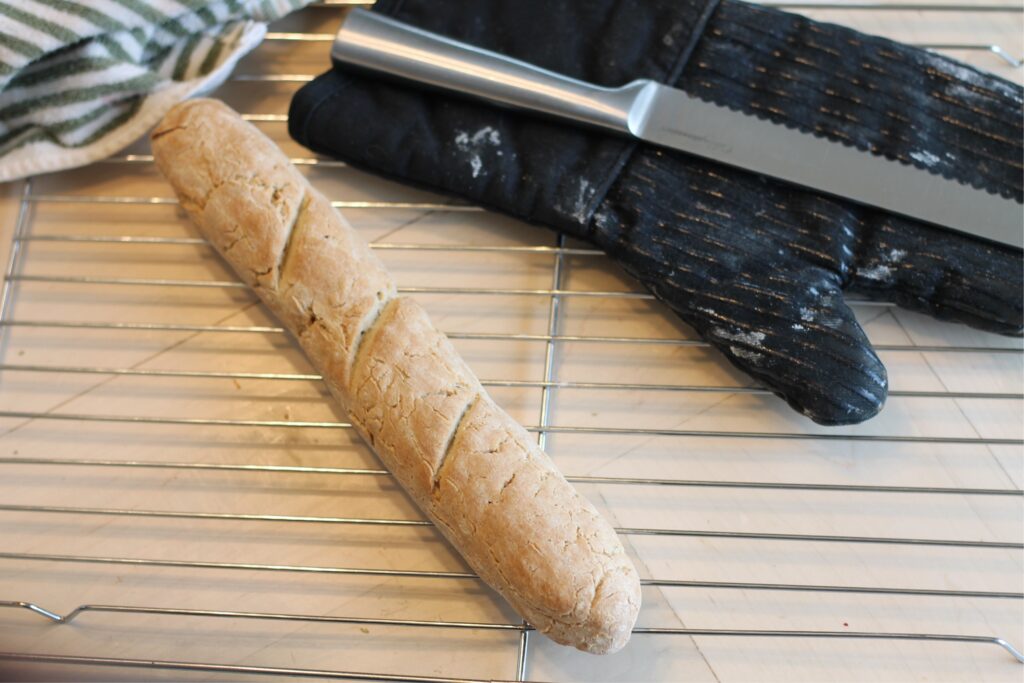
The Joy of Vegan French Baguettes (Top 9 Free)
Few things feel as satisfying as breaking open a warm French baguette. The crisp crust shatters, and the soft crumb inside makes the simplest meal feel special. For anyone who has gone gluten-free, baguettes are often one of the hardest breads to give up. That’s why this recipe is such a treat. It creates a rustic, golden baguette that is free of gluten but still full of character.
I started working on this version because I missed the long, elegant loaves that are perfect with butter, cheese, or soup. Many gluten-free recipes end up more like sandwich bread. They work well, but they don’t capture the romance of the French baguette. This one is different. With a blend of flours, yeast for lift, and a few tricks for crust and shaping, you can bring back that authentic baguette experience.
The crumb is tighter than a wheat baguette, but the flavor is rich and the crust is crisp. If you want more open holes, you can adjust with more water and psyllium. Either way, this recipe gives you the joy of fresh baguettes, right from your oven, with no gluten in sight.
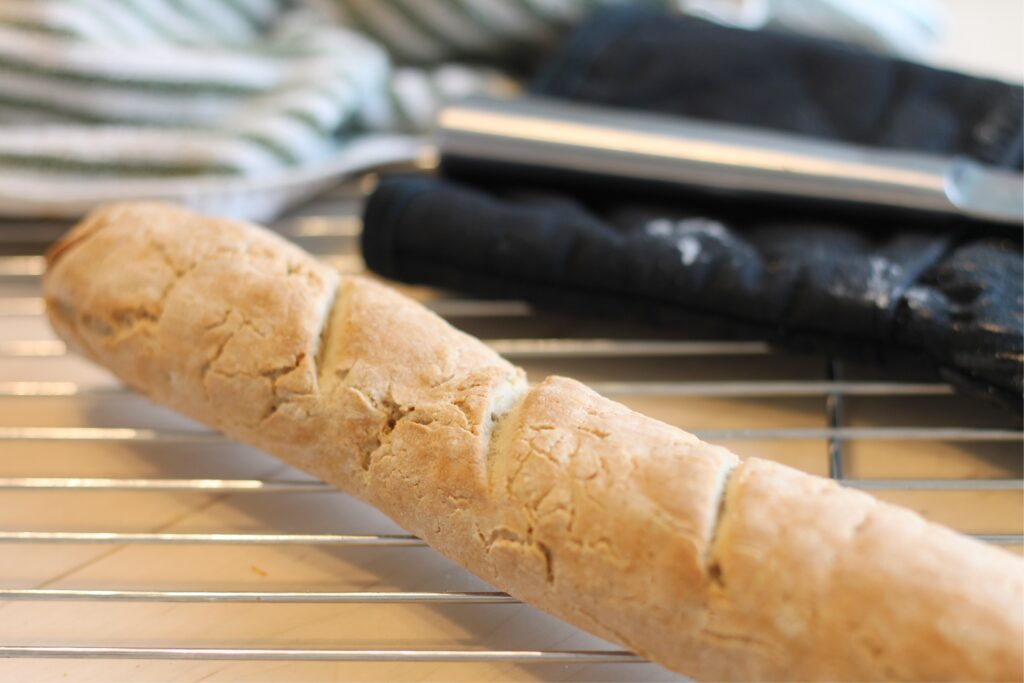
The Story of the French Baguette
The French baguette is more than just bread. It’s a cultural symbol. Its long, thin shape and crackling crust have made it one of the most recognized breads in the world. The exact origin is debated. Some say Napoleon’s bakers created the shape so soldiers could carry bread in their uniforms. Others trace it to Vienna in the 19th century, when steam ovens helped create lighter loaves with crispy crusts.
By the 1920s, the baguette as we know it had become a daily staple in France. In fact, French law has strict rules for what qualifies as a traditional baguette. It must be made only with flour, water, salt, and yeast. Bakers start before dawn so customers can pick up fresh loaves each morning. You can read more about its protected status in French culture from Le Cordon Bleu.
For gluten-free eaters, the challenge is recreating that same look and feel without the gluten structure. Modern recipes use binders like xanthan gum or psyllium to mimic elasticity. It’s a newer twist on a centuries-old bread, but it shows how traditions adapt. For a deeper dive into the baguette’s history and baking techniques, King Arthur Baking has excellent resources.
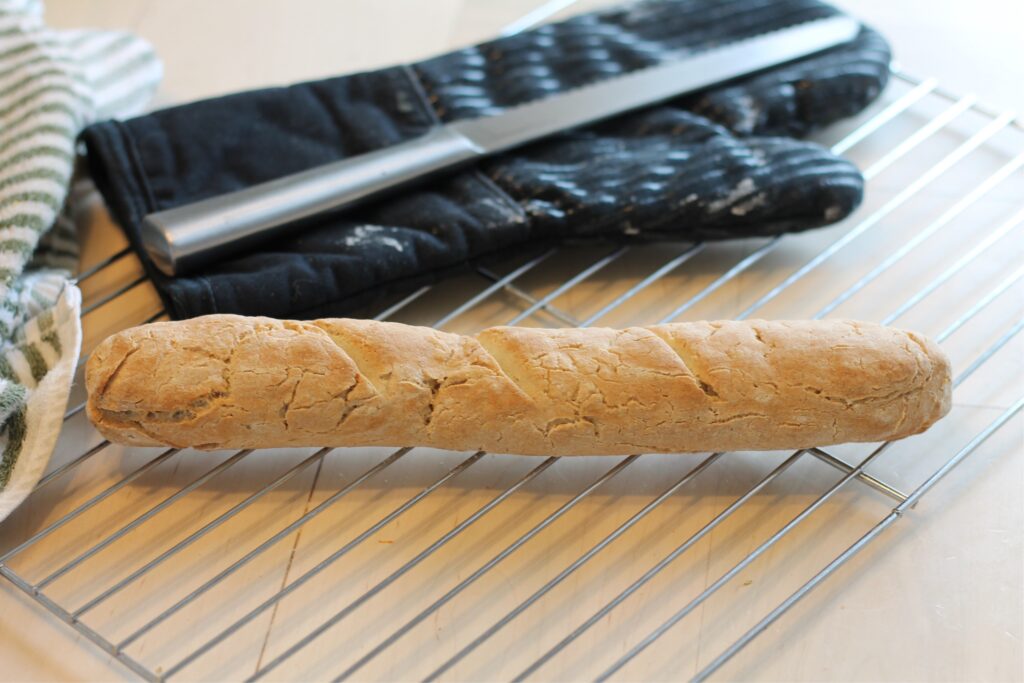
Ingredients and Substitutions
This gluten-free baguette uses simple ingredients. Here’s what you’ll need and what you can swap if needed:
Brown rice flour – gives body and a mild, nutty flavor. Sorghum flour can replace it.
Tapioca starch – adds chewiness and lightness. Potato starch is a backup.
Oat flour – softens the crumb. Millet flour works if oats are not tolerated.
Xanthan gum – binds the dough. Psyllium husk can be used instead.
Salt – for flavor balance.
Sugar – feeds the yeast. Honey or maple syrup also work.
Yeast – for rise and taste. Quick dry yeast is easiest, but active dry yeast works with longer proofing.
Warm water – activates yeast and hydrates the flours.
Olive oil – softens texture and adds depth. Neutral oil or melted butter are fine substitutes.
Superfine white rice flour – for dusting and shaping. Cornstarch or tapioca starch can be used instead.
How to Make Gluten-Free Baguettes
Step 1. Proof the yeast. Mix warm water, sugar, and yeast in a small bowl. Let it sit 5–10 minutes until bubbly. If it doesn’t bubble, the yeast or water temperature may be the issue.
Step 2. Mix dry ingredients. In a large bowl, whisk together the flours, xanthan gum, and salt.
Step 3. Combine. Pour the yeast mixture and olive oil into the flour blend. Stir until you have a sticky dough. No kneading required.
Step 4. Rest. Cover the bowl and let it sit for 15–20 minutes so the flours hydrate.
Step 5. Shape. Dust your surface with rice flour. Roll and fold the dough into a log about 12–14 inches long, resembling a baguette. Handle gently but firmly.
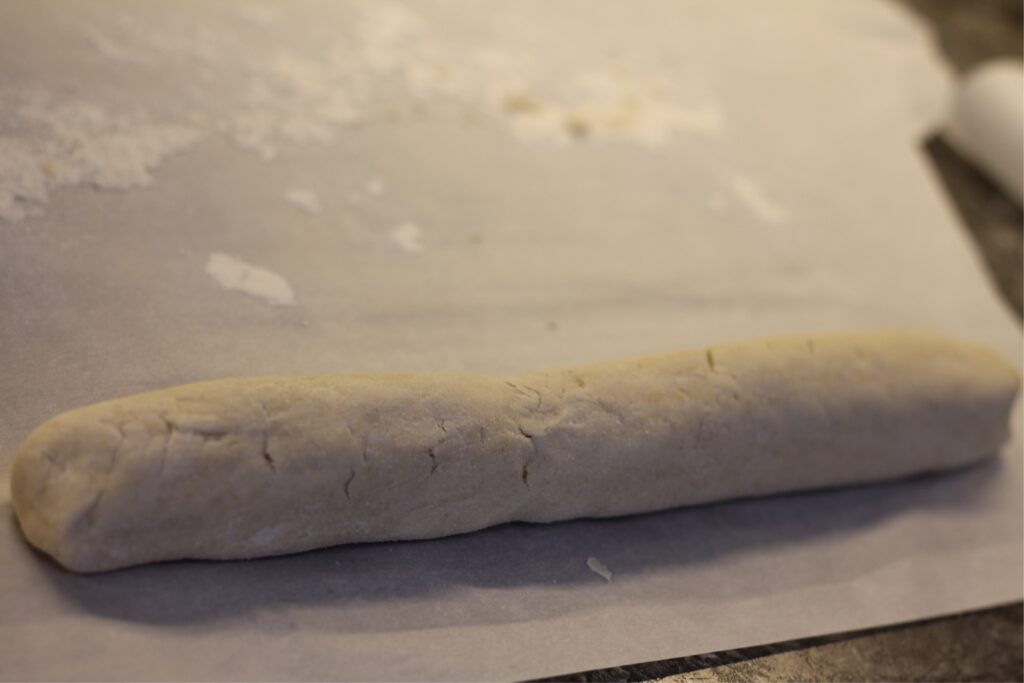
Step 6. Second rest. Place the shaped loaf on a lined baking tray. Rest another 10–15 minutes.
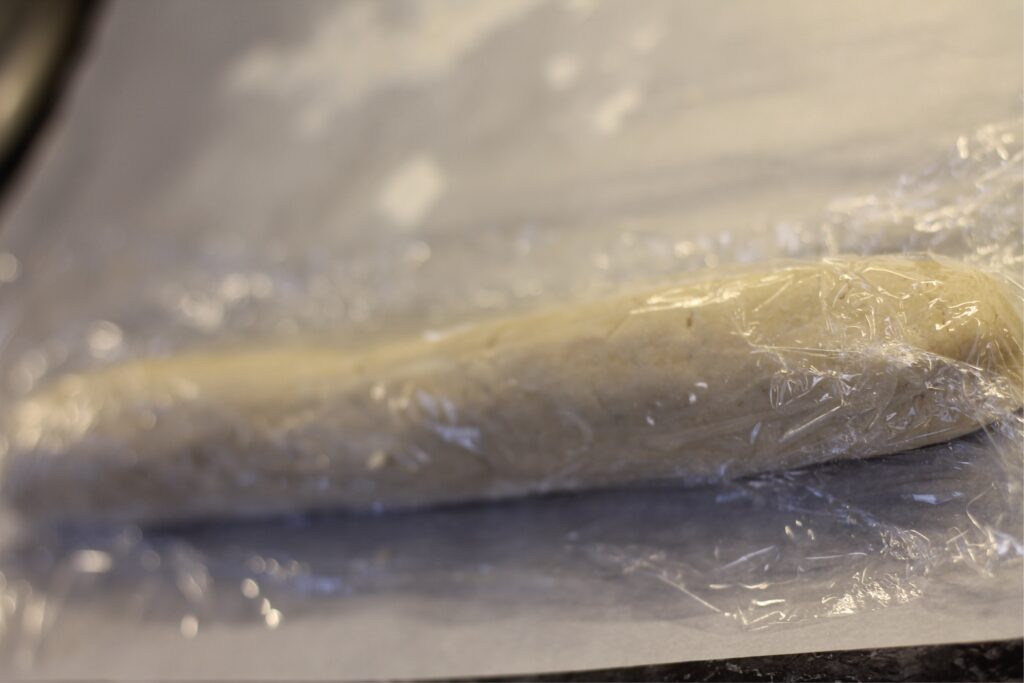
Step 7. Slash. Preheat the oven to 425°F. Brush the top of the baguette lightly with water. Using a sharp knife, make three quick, shallow slashes along the top. Don’t press too deep.
Step 8. Bake. Bake 25–30 minutes until golden brown. Check that the internal temperature reaches 205°F.
Step 9. Cool. Transfer to a wire rack and let the loaf cool before slicing. This step keeps the crumb from turning gummy.
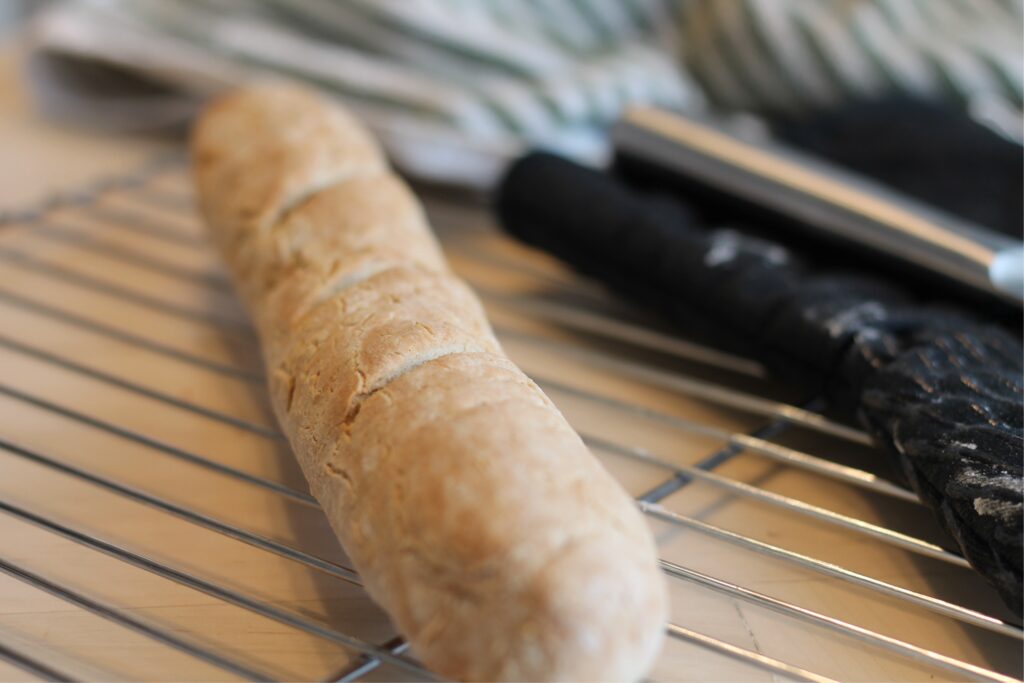
Frequently Asked Questions
Why is my baguette dense?
Gluten-free baguettes often bake up with a tighter crumb. To create more open holes, add 2–3 tablespoons of water and 1 tablespoon psyllium husk powder. The psyllium creates elasticity that traps gas better.
How do I shape sticky dough if I add more water?
When dough is wetter, it’s hard to roll. Try wetting your hands, using a silicone spatula, or transferring it into a baguette pan. The pan supports the dough while it rises and bakes.
Can I bake two baguettes instead of one?
Yes. Divide the dough into two smaller logs. Baking time may be slightly shorter, so check around 20 minutes.
How can I get a more authentic crust?
Steam is the secret. Place an oven-safe dish with hot water on the bottom rack while baking. The steam helps the crust crackle like a bakery baguette.
What if I want a softer crust?
Brush the loaf with melted butter or olive oil right after baking. As it cools, the crust will soften.
Can I freeze these baguettes?
Yes. Cool completely, wrap tightly in foil, and freeze. Reheat in a 350°F oven for 10–12 minutes.
Final Thoughts
Baguettes are a symbol of French culture, and recreating them without gluten feels almost impossible. Yet this recipe shows it can be done at home with patience and the right ingredients. The flavor is true, the crust is crisp, and even though the crumb is tighter, it feels like the real thing. With a few adjustments like psyllium and more water, you can get closer to the open, airy texture.
There’s nothing like hearing the crunch of a slice, or pairing it with soup, salad, or cheese. Gluten-free baking may take extra steps, but the payoff is worth it. Once you try this baguette, you’ll see that even without gluten, you can still enjoy the timeless pleasure of French bread.
Print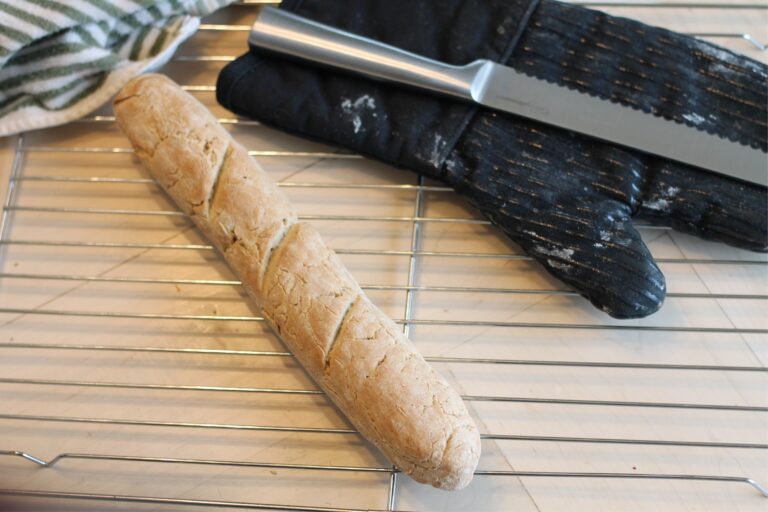
Vegan French Baguette (Soy, Gluten, Nut Free)
A gluten-free, top 9 allergen-free French baguette with a crisp, golden crust, light and airy inside, and a classic slashed top—each bite will whisk you away to a sunny Parisian bakery (without leaving your kitchen!).
Ingredients
- 90 g brown rice flour
- 60 g tapioca starch
- 30 g oat flour (gluten-free)
- 1 tsp (3.5 g) xanthan gum
- ½ tsp (2.5 g) salt
- 6 g sugar
- 3.5 g active quick dry yeast (½ packet)
- 120 ml warm water (100-105F)
- 15 ml olive oil
- Superfine white rice flour, for dusting
Instructions
- Mix warm water + sugar + yeast in a small bowl; wait 5–10 min until bubbly. (If it doesn’t bubble, then try again. Yeast was bad or water not the right temp).
- Mix flours, xanthan gum, and salt in a large bowl.
- Pour yeast mix into large bowl, add oil, stir into sticky dough.
- Cover and rest 15-20 min.
- Dust surface, fold and roll dough to about 12–14 inches long.
- Let shaped loaf rest 10–15 min.
- Preheat oven 425°F. Lightly brush loaf with water. Make 3 quick, shallow slashes on top using a sharp knife—just cut the surface, don’t press hard.
- Bake 25–30 min until golden and internal temp reaches 205°F.
- Cool on a wire rack before slicing.
